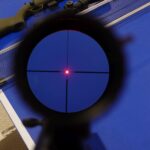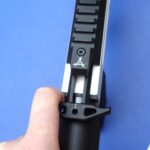In many ways, I’m a cheap, pragmatic hunter. If I can get the job done for much cheaper and at 90% of the performance, I’m good to go. When 17 HMR first came out, I remember thinking about how it was too expensive, and that the performance boost wasn’t worth it for gophers. For the most part, it still isn’t. If you have a really infested field that you’re working, 22 LR is much cheaper and easier on the ears. Where 17 HMR steps out is when you’re cleaning up and pickings are slim.
Price Update Sept 2022: 17 HMR is going for about 50 cents per round ($25 per box of 50) while 22 is about 12 cents per round ($6 per box, depending what you buy).
17 HMR vs 22 LR Trajectory
Let’s just cut straight to the point: you’re looking at 17 HMR to see if it’s worth the extra cost for the increase in distance. 22 LR is still lethal on small varmints out to 100 yards but at that range, it becomes difficult to land hits due to drop in ballistics. 22 LR is heavier and much slower than 17 HMR. Imagine dropping a 22 LR bullet from your hand, how far does it drop given time? That’s the majority of what we’re combating here: the 9.8m/s/s acceleration that planet Earth exerts. The faster your round hits the target, the less time that gravity’s constant acceleration has to pull down on the bullet. So a light, fast bullet can hit a close target faster than a heavy, slow bullet. Much farther out, a heavier bullet can carry more speed further, but let’s just keep things close while we’re talking about rimfire rifles.
Considering a hunting use, the best comparison between 22 LR and 17 HMR is MPBR. That is, how far can you aim on target and still hit game without compensating. It’s a great measure of how flat a particular cartridge shoots. Let’s be demanding and keep our acceptable MPBR (Maximum Point Blank Range) +/- 1.5″, which is a typical scope over bore height and a decent vertical target size for gophers. So let’s see how far 22LR and 17HMR shoot with those numbers. All numbers calculated using ShootersCalculator’s Point blank range.
- In a light 32 grain Stinger 22LR, it’ll give us a workable range from 105 yards
- It’s a bit worse in a heavier 40 grain loading, giving us 90 yards
- In 17 HMR, that’ll give us a workable range up to 163 yards. That’s a great, usable range for things like gophers and more than 50% more range than 22 LR gave us.
So what’s double the distance worth? If you’ve been shooting 22LR at small game around the 80-120 yard range, I’ll bet it’s worth a lot. Is it worth quadruple the price in ammunition? That’s a question only you can answer. For me, ammunition is only a small cost of shooting gophers compared to gas and maintaining connections and good will to be able to shoot on someone else’s land. For me, it also comes down to personal satisfaction. Am I satisfied missing the far gophers, and only cleaning up the ones that are closer because my rifle shoots bullets that are 20 cents cheaper? Absolutely not. I’ll pay the extra per round for the additional accuracy and range. I’ll pay the extra to confidently stretch my shots past 100 yards and not worry about drop. And I’ll pay for the extra damage that 17 HMR does on small game, because at the end of the day, I’m out shooting gophers for a purpose, and 17 HMR is just flat out better at that purpose than 22 LR. (for long range) Want more info? check out my article on the 17 WSM.






